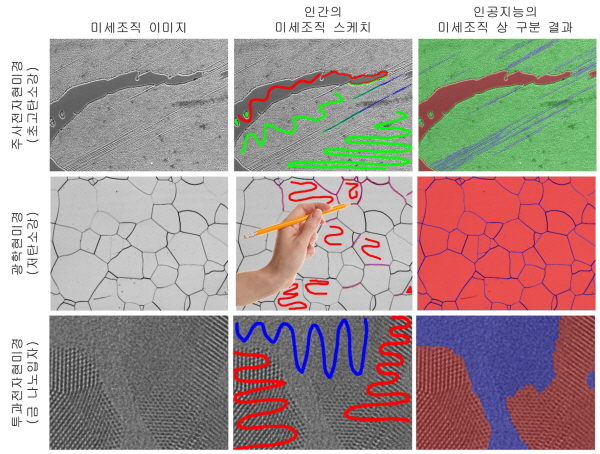과학기술정보통신부 산하 정부출연연구기관인 한국재료연구원(KIMS, 원장 이정환)이 인간과 인공지능과의 협업으로 재료의 미세조직 분석을 쉽고 빠르게 할 수 있는 방법을 개발해 다양한 분야에서 널리 활용될 것으로 기대되고 있다.
재료硏·포항공대, 미세조직 상 구분 프레임워크 개발
과학기술정보통신부 산하 정부출연연구기관인 한국재료연구원(KIMS, 원장 이정환)이 인간과 인공지능과의 협업으로 재료의 미세조직 분석을 쉽고 빠르게 할 수 있는 방법을 개발해 다양한 분야에서 널리 활용될 것으로 기대되고 있다.
재료연구원은 재료디지털플랫폼연구본부 소재데이터센터 김세종, 나주원 박사 연구팀이 포항공과대학교 이승철 교수 연구팀과 함께 인간과 인공지능(AI)의 상호작용을 통해 현미경 이미지로부터 재료의 미세조직 상을 자동으로 구분하고 정량화하는 기술을 개발했다고 28일 밝혔다.
현미경 이미징 시스템은 나노(nano)에서 메소(meso) 스케일에 이르기까지 다양한 수준에서 재료 구조의 정보를 시각화해 제공한다. 미세조직의 정량 분석은 이러한 현미경 이미지로부터 미세조직 상을 구분해 정량적인 정보를 추출하는 과정이다.
반면에 미세조직의 복잡성과 다양성으로 인해 인간 또는 인공지능이 이를 단독으로 수행하기엔 지금까지 많은 한계가 존재했다.

▲인간-AI 협업 기반 미세조직 상 구분
연구팀은 인간과 인공지능의 역량을 효과적으로 통합함으로써 신소재 개발 과정에서 범용적으로 활용 가능한 통합 미세조직 정량 분석 프레임워크(frame work)를 개발했다.
이 기술은 인공지능이 단 한 장의 미세조직 이미지와 이에 대한 전문가의 대략적인 스케치만으로 미세조직 상 구분작업을 수행하게끔 한다.
또한 인공지능은 전문가에게 능동적으로 스케치를 요구해 인간과 적극적인 상호작용을 보인다. 연구팀은 광범위한 실험을 통해, 인간-인공지능의 협력 프레임워크가 다양한 재료, 미세조직, 현미경 시스템에 걸쳐 범용적으로 활용될 수 있음을 확인했다.
지금까지의 연구가 노동 집약적인 대량의 학습 자료 수집을 요구해왔다면, 이번 연구는 전문가의 펜과 마우스를 이용한 단순 스케치만으로 이를 대체했다는 점에 실용성이 크게 향상됐다고 평가받는다.
향후 이 기술은 재료연이 개발하고 있는 미세조직 자동 정량 분석 시스템(TIMs)에 내재화해 일반 연구자가 쉽게 사용할 수 있도록 제공할 예정이다.
재료연 나주원 선임연구원은 “이번 연구는 기존의 주관적이며 시간 소모적인 미세조직 정량 분석 작업을 객관적이며 자동화된 작업으로 개선한 결과”라고 말했다.
또한 포항공과대학교 이승철 교수는 “전문가와 상호작용하는 인공지능 프레임워크는 산업체 및 연구 현장에서 핵심 분석 기술로 폭넓게 사용될 것으로 예상된다”며 “이를 통해 신소재 연구개발의 비용과 시간을 획기적으로 단축하고 더 나아가 신뢰성까지 크게 향상할 것으로 기대한다”고 말했다.
이번 연구는 과학기술정보통신부 지원으로 한국재료연구원 기본사업, 한국연구재단 중견연구자지원사업, 산업통상자원부 알키미스트사업을 통해 수행됐다.
또한 연구 결과는 금속재료 분야 최고 권위지인 ‘악타 머터리얼리아(Acta Materialia, 제1저자: 나주원 박사)’에 8월15일자로 게재됐다.
.jpg)
▲(왼쪽부터)재료연 김세종 책임연구원, 나주원 선임연구원, 포항공과대학교 이승철 교수
.jpg)